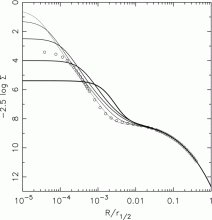
Abstract
Two-body relaxation times of nuclear star clusters are short enough that gravitational encounters should substantially affect their structure in 10 Gyr or less. In nuclear star clusters without massive black holes, dynamical evolution is a competition between core collapse, which causes densities to increase, and heat input from the surrounding galaxy, which causes densities to decrease. The maximum extent of a nucleus that can resist expansion is derived numerically for a wide range of initial conditions; observed nuclei are shown to be compact enough to resist expansion, although there may have been an earlier generation of low-density nuclei that were dissolved. An evolutionary model for NGC 205 is presented which suggests that the nucleus of this galaxy has already undergone core collapse. Adding a massive black hole to a nucleus inhibits core collapse, and nuclear star clusters with black holes always expand, due primarily to heat input from the galaxy. The expansion rate is smaller for larger black holes due to the smaller temperature difference between galaxy and nucleus when the black hole is large. The rate of stellar tidal disruptions and its variation with time are computed for a variety of initial models. The disruption rate generally decreases with time due to the evolving nuclear density, and is lower in smaller galaxies, assuming that scaling relations derived for luminous galaxies can be extended to low luminosities.